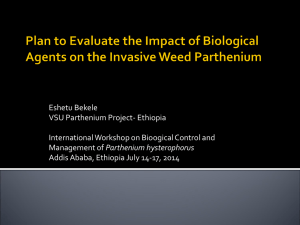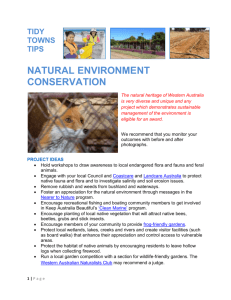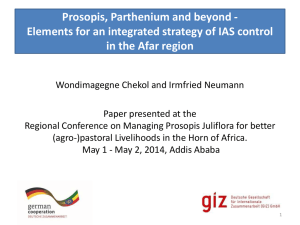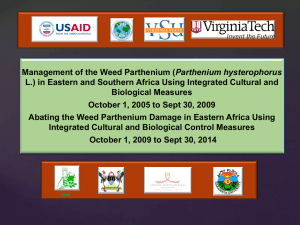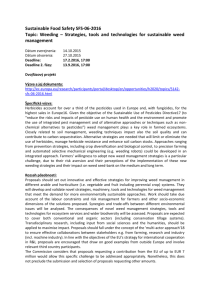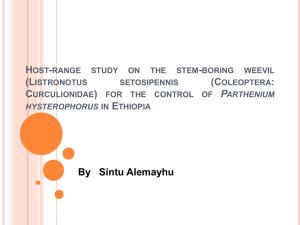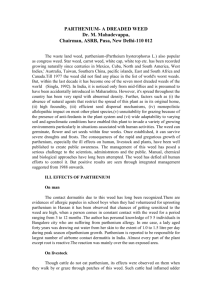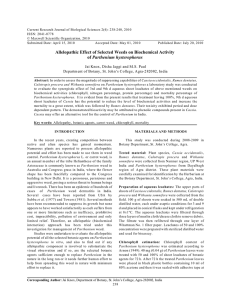Proclaimed Plant Policy
advertisement
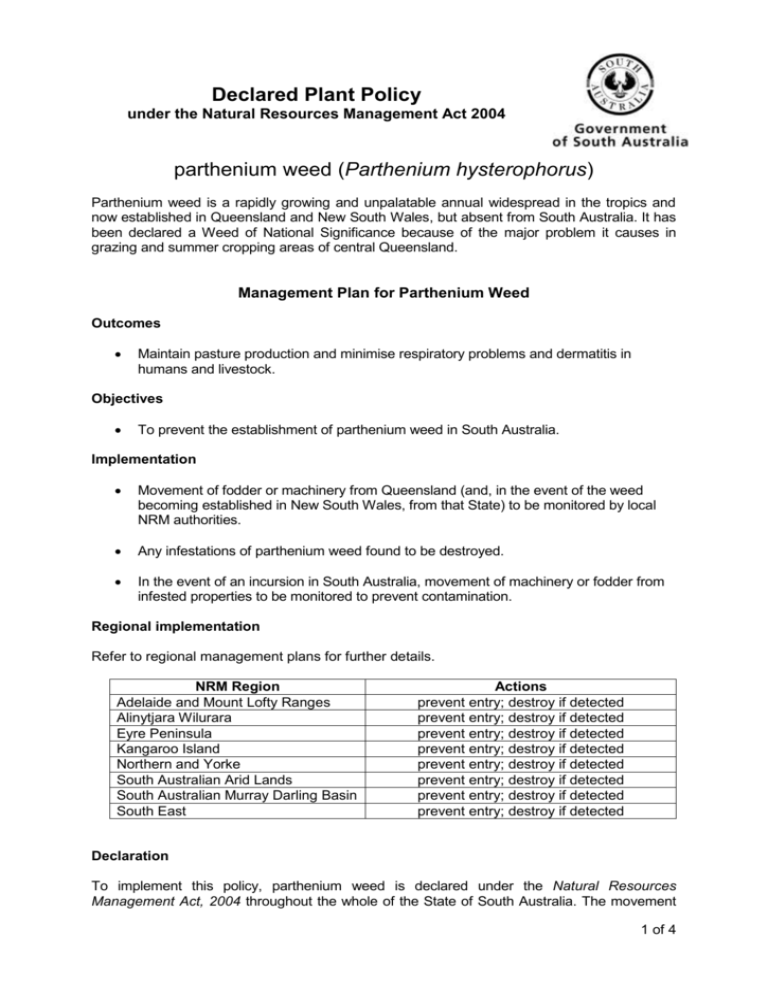
Declared Plant Policy under the Natural Resources Management Act 2004 parthenium weed (Parthenium hysterophorus) Parthenium weed is a rapidly growing and unpalatable annual widespread in the tropics and now established in Queensland and New South Wales, but absent from South Australia. It has been declared a Weed of National Significance because of the major problem it causes in grazing and summer cropping areas of central Queensland. Management Plan for Parthenium Weed Outcomes Maintain pasture production and minimise respiratory problems and dermatitis in humans and livestock. Objectives To prevent the establishment of parthenium weed in South Australia. Implementation Movement of fodder or machinery from Queensland (and, in the event of the weed becoming established in New South Wales, from that State) to be monitored by local NRM authorities. Any infestations of parthenium weed found to be destroyed. In the event of an incursion in South Australia, movement of machinery or fodder from infested properties to be monitored to prevent contamination. Regional implementation Refer to regional management plans for further details. NRM Region Adelaide and Mount Lofty Ranges Alinytjara Wilurara Eyre Peninsula Kangaroo Island Northern and Yorke South Australian Arid Lands South Australian Murray Darling Basin South East Actions prevent entry; destroy if detected prevent entry; destroy if detected prevent entry; destroy if detected prevent entry; destroy if detected prevent entry; destroy if detected prevent entry; destroy if detected prevent entry; destroy if detected prevent entry; destroy if detected Declaration To implement this policy, parthenium weed is declared under the Natural Resources Management Act, 2004 throughout the whole of the State of South Australia. The movement 1 of 4 parthenium weed policy or transport of the plant on a public road by itself or as a contaminant, its entry to South Australia, or the sale by itself or as a contaminant are prohibited. Notification of infestations is necessary to ensure these are destroyed. Land owners are required to destroy any parthenium weed plants growing on their land. NRM authorities are required to destroy plants on road reserves, and may recover costs from the adjoining land owners. Parthenium weed is declared in category 1 under the Act, for the purpose of setting maximum penalties and for other purposes. Any permit to allow its movement or sale can only be issued by the Chief Officer pursuant to section 188. Under the Natural Resources Management (General) Regulations 2005, the transport or movement of grain for milling or wool for cleaning is exempt from the operation of sections 175 and the sale of wool or grain is exempt from section 177(2) if at the time of the sale the person believes on reasonable grounds that the purchaser will remove the plant from the wool or grain before any re-sale. The following sections of the Act apply to parthenium weed throughout each of the NRM regions noted below: EP KI NY SAAL SAMDB SE 175(1) Prohibiting entry to area 175(2) Prohibiting movement on public roads 177(1) Prohibiting sale of the plant 177(2) Prohibiting sale of contaminated goods 180 Requiring notification of infestations 182(1) Landowners to destroy the plant on their properties 182(2) Landowners to control the plant on their properties 185 Recovery of control costs on adjoining road reserves AW Sections of Act AMLR Region X X X X X X X X X X X X X X X X X X X X X X X X X X X X X X X X X X X X X X X X X X X X X X X X X X X X X X X X Review Success of the program will be measured by its effectiveness in preventing any outbreaks of parthenium weed in South Australia. This policy is to be reviewed by 2020, or in the event of parthenium weed becoming established in South Australia, or any change in its status as a Weed of National Significance. Weed Risk Invasiveness Parthenium weed is a fast-maturing annual (or short-lived perennial) that can germinate and set seed in four weeks under ideal conditions. Experience in the eastern States has shown that it establishes readily on roadsides, fencelines and disturbed ground. Parthenium weed produces large numbers of small seeds that are easily spread in contaminated fodder and pasture seed, and also move on vehicles, machinery (particularly grain harvesters) and livestock. It can rapidly colonise sites with sparse groundcover or bare soil. It is a strong competitor in pasture, excluding desirable species in neglected or overstocked paddocks, but is not likely to invade well-managed pastures or cropped land. 2 of 4 parthenium weed policy Impacts The plant is a serious allergen, causing respiratory problems and dermatitis in humans as well as skin reactions in stock grazing infested paddocks. It is toxic to cattle, and meat from livestock that eat it can become tainted. It allelopathically inhibits the germination and growth of some plants including valuable pasture grasses. Although it is not primarily a weed of crops, the potential loss of export markets due to parthenium weed seed contamination is emerging as an issue for some industries in the eastern States. Potential distribution Its potential distribution in South Australia extends from the Riverland to the Port Augusta area especially on alkaline, clay-loam to heavy clay soils. There is also potential for parthenium weed to enter SA along the Warburton and Coopers Creeks in wet years if it becomes established in the Channel Country of Queensland. Feasibility of Containment Control costs Control in pasture requires improved pasture management. Broadacre applications of a knockdown herbicide combined with a residual can greatly reduce infestations if applied at the appropriate time, and final eradication of the weed from a paddock requires spot herbicide treatment followed up for several years to catch seedling regrowth. Persistence Parthenium weed forms a large seedbank in the soil, with a percentage of its seeds entering dormancy and persisting for several years. Current distribution Not yet found in South Australia, but infests over 8 million hectares of central Queensland with isolated infestations in southern Queensland. Incursions into New South Wales, which are subject to eradication programs, have been as far south as the Victorian border. State Level Risk Assessment Assessment using the Biosecurity SA Weed Risk Management System gave the following comparative weed risk and feasibility of containment scores by land use: Land use Grazing - southern Irrigated pastures Vegetables Urban Weed Risk medium 88 medium 51 negligible 11 negligible 4 Feasibility of control very high 0 very high 0 very high 0 very high 0 Response at State Level contain spread, alert contain spread, alert monitor monitor 3 of 4 parthenium weed policy Considerations Parthenium weed is native to the Caribbean region and has spread as a weed around the tropics of the world. It has been established in Queensland since 1955 and is rapidly spreading in that State; it reached New South Wales in 1982. It is a major problem in grazing and summer cropping areas of Queensland. It has a serious impact on the pastoral industry, costing farmers and graziers in Queensland over $22 million a year in reduced production and increased management costs. Risk assessment indicates containment as a management action. However, since parthenium weed is still absent from South Australia, containment is best implemented by preventing its entry to and establishment in the State. Due to its medium weed risk, absence from the State and very high feasibility of control, parthenium weed is regarded as a State Alert Weed and a high priority surveillance target to increase the likelihood of early detection. Synonymy Parthenium hysterophorus L., Sp. Pl. 2: 988. (1753). Taxonomic synonyms: Argyrochaeta bipinnatifida Cav., Icon. [Cavanilles] 4: 54. I. 378 (1791) Echetrosis pentasperma Phil., Anales Univ. Chile 129 (1873) Parthenium glomeratum Rollins, Contr. Gray Herb. 172: 59 (1950) Parthenium lobatum Buckley, Proc. Acad. Nat. Sci. Philadelphia 1861 457 (1862) Other common names include bitterweed, carrot grass, congress grass, false ragweed, ragweed parthenium, whitetop, bitter broom, carrot grass, santa maria, santa maria feverfew, whitehead, ragweed parthenium References Agriculture & Resource Management Council of Australia & New Zealand Australia & New Zealand Environment & Conservation Council and Forestry Ministers (2001) 'Weeds of National Significance Parthenium Weed (Parthenium hysterophorus) Strategic Plan.' (National Weeds Strategy Executive Committee: Launceston) Chamberlain, J. & Gittens, A. (2004) ‘Parthenium Weed Management’. (Department of Natural Resources, Mines and Energy: Brisbane). Hon Ian Hunter MP Minister for Sustainability, Environment and Conservation Date: 28 July 2014 4 of 4
